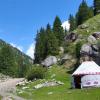Search
Displaying Results 1 - 13 of 13
Uzbekistan took another step towards monitoring sustainable forest management in support of the Sustainable Development Goals.On 8-10 August 2018, more than 30 forestry experts from Uzbekistan, Turkey and the Russian Federation met in Tashkent, Uzbekistan, to review a draft set of criteria and
Forests in Uzbekistan cover about 7% of the land area and play an important role in the protection and prevention of environmental degradation, in particular land degradation, natural disasters, and conservation of biodiversity and preservation of water quality. Moreover, wood is an important
After independence, Armenia, Georgia, Kazakhstan, Kyrgyzstan and Uzbekistan struggled with the big task to build their own systems leading forestry into sustainability. The problems and challenges are diverse and often country specific. In Kazakhstan and Uzbekistan afforestation is used to fight
In the past years, Central Asia has been facing major climate-change related challenges – drought, floods, desertification, sandstorms, extreme cold and heat spells – and many more. Not only have these affected rural areas, but cities have been suffering, too. Accentuated by increased traffic
No country in the Caucasus or Central Asia prior to 2016 had developed indicators to monitor progress towards sustainable forest management at the national level. Two years later, thanks to a United Nations Development Account (UNDA) project implemented jointly by UNECE and FAO, five countries
The Caucasus and Central Asia accounts for over 30 million hectares of forests and wooded lands, an area approximately the size of Italy Forest landscape restoration in this area is critical for supporting livelihoods and local economies, preventing soil erosion and desertification, enhancing
Four years ago, the countries in the Caucasus and Central Asian region pledged to restore more than 3 million hectares of degraded forests by 2030 under the global Bonn Challenge. To support them in turning their pledges into reality, the United Nations Economic Commission for Europe (UNECE) and
In recent years, countries in the Caucasus and Central Asia have made significant progress in developing national forest monitoring systems and have committed to implement large-scale forest landscape restoration. The Astana Resolution and the commitment of the region in 2018 to restore over 2.5
For the second time under the UNECE/FAO project “Accountability Systems for Sustainable Forest Management in the Caucasus and Central Asia”, Kyrgyz stakeholders met to advance their national criteria and indicator set for sustainable forest monitoring. This exercise is especially important as
Kazakhstan has taken another step towards monitoring sustainable forest management in support of the Sustainable Development Goals by including socio-economic and governance indicators in the country’s forest monitoring system.National forest monitoring systems and assessments are designed to
Sustainable forest management indicators developed through a participatory process can provide important information on forest resources and support evidence-based forest policies. The concept of criteria and indicators, integrating social, economic and ecological aspects, was developed
Armenian forests are among the most threatened ecosystems, with degradation accelerating, largely attributable to deforestation and overexploitation. Thus, “expansion of forests is one of the main goals for Armenia, not only for the forests’ protective role, but also to develop forest-related
Four thousand kilometers away from the UNECE headquarters in Geneva used to lie the Aral Sea. It was the fourth biggest lake in the world, in fact the lake was bigger than Switzerland. But if we travelled there today, we would only find a desert as the lake has dried out. The Caucasus and




